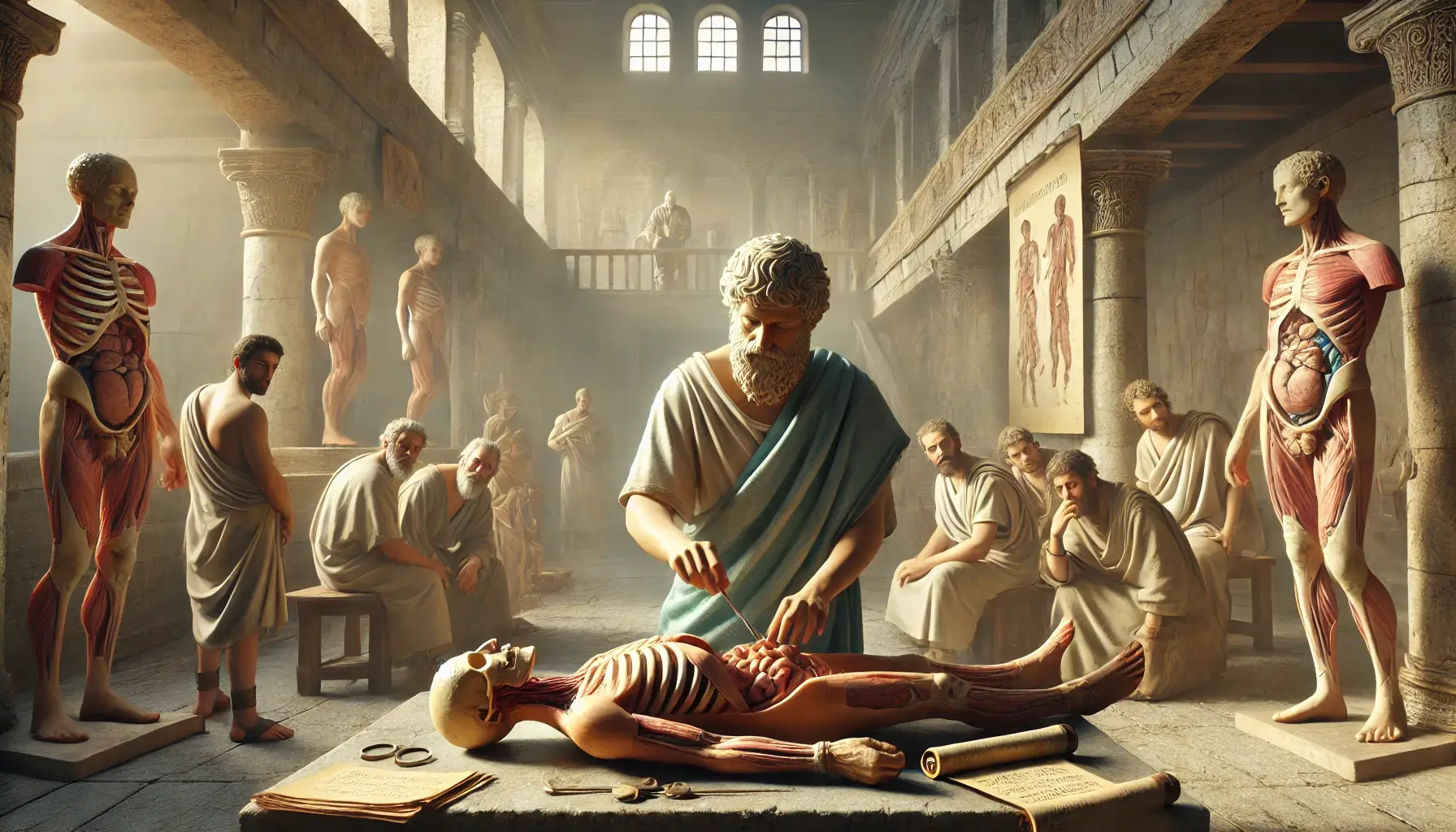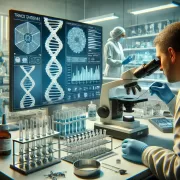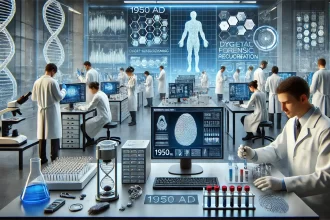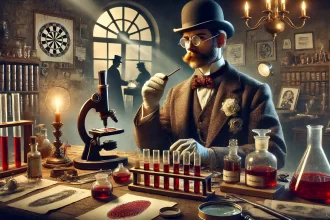Introduction: Breaking the Boundaries of Ancient Medicine
Imagine a world where exploring the inside of the human body was considered forbidden, a time when touching the sacred remains of the deceased could land you in serious trouble. Yet, in 300 BC, one man dared to defy these societal taboos, revolutionizing the field of medicine forever. That man was Herophilus, widely regarded as the Father of Anatomy. He conducted the first documented human dissections, setting the foundation for modern medicine as we know it.
Herophilus’ work in Alexandria challenged traditional beliefs about human anatomy and paved the way for future discoveries in the nervous, cardiovascular, and various organs. His contributions have echoed through the centuries, making him one of the most influential figures in the history of medical science. In this article, we delve into the revolutionary nature of Herophilus’ dissections and explore the questions that have intrigued scholars and historians alike.
To explore more milestones in the evolution and other key advancements in forensic science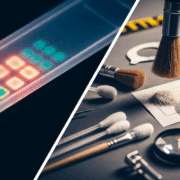
- Introduction: Breaking the Boundaries of Ancient Medicine
- The Life and Legacy of Herophilus: Who Was He?
- Did Herophilus Dissect Humans?
- Why Was Human Dissection Banned in Most Places?
- Why Was Alexandria Important for Medicine?
- Was It Ethical?
- Herophilus’s Groundbreaking Anatomical Discoveries
- The Brain and Nervous System: A Revolutionary Perspective
- The Cardiovascular System: A Detailed Understanding
- The Digestive and Reproductive Systems
- Herophilus’s Contributions to Medical Practice
- Herophilus’s Contemporaries: Collaboration with Erasistratus
- References
- Conclusion: A Medical Pioneer
The Life and Legacy of Herophilus: Who Was He?
Herophilus was a Greek physician born in Chalcedon (modern-day Turkey) around 335 BC. He later moved to Alexandria, Egypt, a city renowned for its intellectual and cultural openness. Here, under the patronage of the Ptolemaic rulers, Herophilus conducted his groundbreaking work in anatomy. The Alexandrian School of Medicine, where Herophilus flourished, was a unique institution that allowed the dissection of human bodies, a practice banned in most parts of the ancient world.
Why Was Herophilus Famous?
Herophilus became famous for his detailed anatomical research, particularly in the nervous, brain, and cardiovascular systems.
- Herophilus was the first to systematically dissect human bodies, which enabled him to make significant discoveries about human anatomy.
- He differentiated between sensory and motor nerves, a revolutionary distinction that laid the groundwork for future neurological studies.
- Recognize the brain as the center of intelligence, debunking the common belief that the heart is the seat of thought.
Did You Know?
Herophilus used a water clock to measure the rhythm of the pulse, a groundbreaking method that laid the foundation for modern diagnostics. His insights into arterial pulsations helped physicians understand how blood circulates through the body. Could this have been the earliest form of cardiovascular health monitoring?
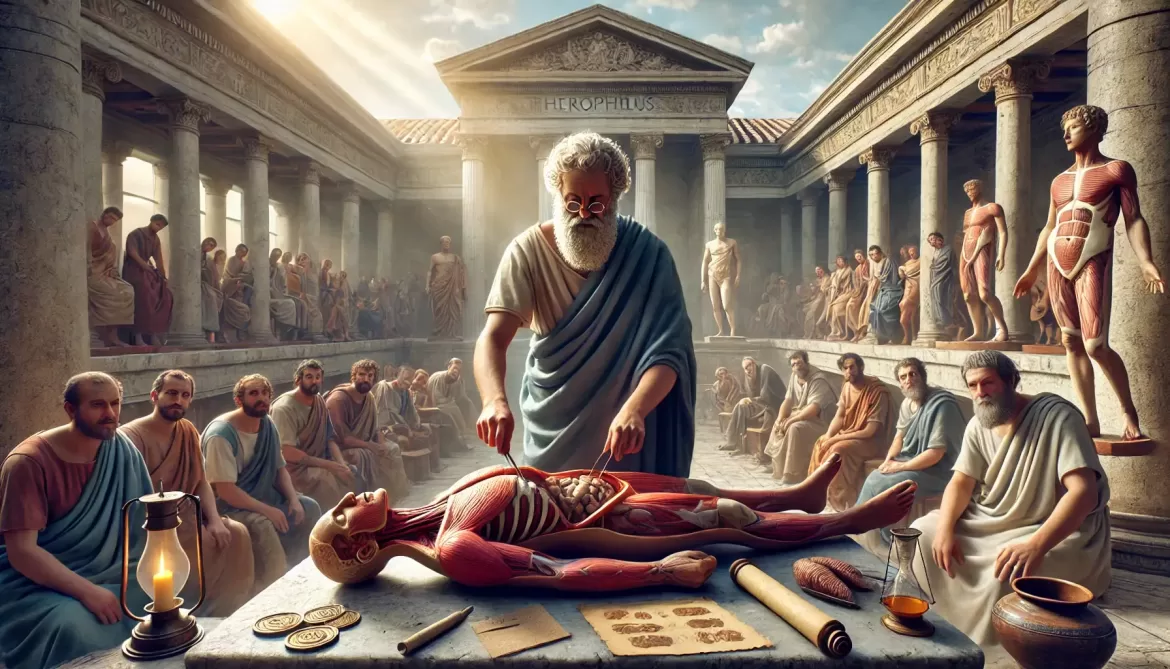
Did Herophilus Dissect Humans?
Herophilus was one of the first documented anatomists to perform human dissections. In Alexandria’s intellectually liberated atmosphere, He was granted permission to study human cadavers, and his findings led to several revolutionary discoveries about the human body.
Why Was Human Dissection Banned in Most Places?
In many ancient cultures, human dissection was strictly prohibited due to religious and cultural taboos. The human body was seen as sacred, and its desecration after death was believed to prevent the soul’s journey to the afterlife. However, Alexandria’s emphasis on scientific progress and learning became the ideal setting for Herophilus to conduct his research.
Why Was Alexandria Important for Medicine?
The unique environment in Alexandria allowed for groundbreaking research. Here, scholars like Herophilus and his contemporary Erasistratus were able to push the boundaries of medical knowledge, conducting dissections that were unprecedented in scope and depth. These dissections were used not only for personal study but were often performed publicly, turning anatomy into an educational experience for students and fellow physicians.
Was It Ethical?
Herophilus’ pioneering contributions to medical science were marred by practices that would be deemed highly unethical today. Historical records suggest that he conducted vivisections on living prisoners, a method that, while providing unprecedented insights into human anatomy, raises serious moral questions. This controversial aspect of his research underscores the tension between the pursuit of scientific knowledge and ethical considerations, highlighting how standards have evolved to prioritize consent and dignity.
Herophilus’s Groundbreaking Anatomical Discoveries
Herophilus’s systematic dissections of human cadavers were revolutionary, allowing him to make detailed observations about the human body. His discoveries ranged from the brain and nervous system to the cardiovascular system, digestive organs, and reproductive system. Each of these findings had a profound impact on the development of medicine.
The Brain and Nervous System: A Revolutionary Perspective
One of Herophilus’s most significant contributions was his work on the nervous system. Through his dissections, he was the first to differentiate between sensory nerves, which transmit information from the body to the brain, and motor nerves, which send instructions from the brain to the muscles.
- Sensory vs. Motor Nerves: Previous scholars like Praxagoras had speculated about nerves, but Herophilus was the first to distinguish clearly between motor and sensory functions. He observed that motor nerves control movement, while sensory nerves are responsible for feeling, laying the foundation for modern neuroscience.
- The Brain as the Seat of Intelligence: Herophilus challenged the then-dominant belief that the heart was the seat of intelligence. Through his dissections, he determined that the brain, not the heart, was responsible for thought, sensation, and motor control. This was a groundbreaking shift in medical understanding, particularly in the field of neuroanatomy.
- Anatomy of the Brain: Herophilus made several important discoveries about the brain itself. He was the first to distinguish between the cerebrum and cerebellum, recognizing that these different parts of the brain served different functions. He also described the ventricular system, which contains the cerebrospinal fluid, and he identified the meninges, the protective layers surrounding the brain.
Herophilus’s research on the nervous system extended to the cranial nerves. He described the optic, oculomotor, trigeminal, facial, vestibulocochlear, and hypoglossal nerves and provided the first accurate descriptions of the eye and its various layers, including the cornea, iris, retina, and choroid.
The Cardiovascular System: A Detailed Understanding
Herophilus’s investigations into the cardiovascular system were equally pioneering. Through his dissections, he was able to differentiate between arteries and veins, challenging the prevailing belief that veins carried both blood and air.
- Discovery of Arterial Function: Herophilus noted that arteries were thicker and more robust than veins, leading him to conclude that they carried blood under pressure. He correctly linked arterial pulsations to the heartbeat, demonstrating that the heart moved blood throughout the body.
- Pulse Measurement: Herophilus was the first to use a water clock to measure the pulse, creating a standardized method for assessing the rhythm and strength of a patient’s pulse. This was a significant advancement in diagnostic medicine, as the pulse became an important indicator of a person’s overall health.
- Blood Flow and Heart Structure: While Herophilus did not fully understand the concept of blood circulation, he made significant strides in understanding blood flow and the structure of the heart. He recognized the importance of the atria as part of the heart’s function, an insight that would later influence more advanced theories of circulation.
The Digestive and Reproductive Systems
Herophilus also made significant discoveries in the study of the digestive and reproductive systems. His dissections revealed important details about these often-overlooked areas of human anatomy.
- The Digestive System: Herophilus was the first to name the duodenum, the first part of the small intestine. He described the salivary glands and provided a detailed analysis of the liver and pancreas. His work on the liver, in particular, gave the first accurate descriptions of its shape and function.
- The Reproductive System: In his studies of the reproductive system, Herophilus provided groundbreaking insights. He accurately described the ovaries, uterus, and fallopian tubes, differentiating these structures from male reproductive organs. His book, Midwifery, discussed the stages of pregnancy and provided practical advice for midwives on handling complications during childbirth.
| Body System | Herophilus’ Contribution | Impact on Modern Medicine |
|---|---|---|
| Nervous System | Distinction between sensory and motor nerves | Foundation of modern neuroscience |
| Cardiovascular System | Arteries carry blood, pulse linked to heart function | Basis of cardiovascular diagnostics |
| Reproductive System | Detailed description of ovaries, fallopian tubes, uterus | Improved understanding of female reproductive health |
| Digestive System | Naming of duodenum, study of liver and pancreas | Advancements in gastroenterology |
Herophilus’s Contributions to Medical Practice
While Herophilus is most well-known for his anatomical discoveries, he also made important contributions to medical practice. His innovations in diagnosis, treatment, and surgery profoundly impacted how medicine was practiced for centuries.
Pulse Measurement: A Diagnostic Revolution
Herophilus was the first to measure the pulse with precision, using a water clock to calculate the timing of arterial contractions. His method introduced a new level of accuracyIn scientific and measurement contexts, "accuracy" refers to the degree of proximity or closeness between a measured value and the true or actual value of the measured quantity. Accuracy indicates how well a measurement reflects Read Full Definition in medical diagnostics, enabling physicians to diagnose cardiovascular diseases based on pulse irregularities. His study of pulse rhythms became so advanced that he compared them to musical rhythms, identifying patterns that indicated specific health conditions (Hajar, 2018).
Pharmacology and Therapeutics
Herophilus’s work extended into the realm of pharmacology, where he placed great emphasis on the use of herbs and other natural substances in medical treatment. He believed in the curative power of dietetics, exercise, and simple remedies, often using compoundIn scientific terminology, a "compound" refers to a substance formed by the combination of two or more different elements or molecules. These elements or molecules can be chemically bonded together to create a new substance Read Full Definition drugs made from plants, minerals, and even animal products.
He referred to pharmacological remedies as the “hands of the gods”, and his approach was considered advanced for his time. His book on pharmacology, although lost, was referenced for centuries.
Surgical Techniques
Due to his extensive knowledge of anatomy, Herophilus was able to develop more precise"Precise" refers to the degree of closeness or consistency between multiple measurements or values taken under the same conditions. It indicates how well these measurements agree with each other, regardless of whether they are accurate Read Full Definition surgical techniques, especially in the field of ophthalmology. His detailed understanding of the eye’s anatomy, including the cornea, retina, choroid, and iris, allowed him to innovate in the treatment of eye conditions, setting the stage for later advancements in eye surgery.
Herophilus’s Contemporaries: Collaboration with Erasistratus
Among Herophilus’s notable contemporaries was Erasistratus, another leading figure in anatomy and physiology. Together, they worked at the Alexandrian School of Medicine, performing public dissections and teaching students from across the ancient world.
- Herophilus vs. Erasistratus: While Herophilus focused on anatomy, Erasistratus contributed primarily to physiology, particularly the cardiovascular system study. Their complementary expertise allowed for a more comprehensive understanding of the human body, and their combined efforts set the foundation for future generations of physicians.
The Loss of Herophilus’s Works
Herophilus authored at least nine major medical texts during his lifetime, including treatises on anatomy, pulse diagnosis, and midwifery. These texts were housed in the Great Library of Alexandria, where they remained for nearly 700 years. Tragically, all of his original writings were destroyed in the fire that consumed the library in 391 CE. Today, our knowledge of Herophilus’s work comes from later physicians like Galen, who referenced and expanded upon his discoveries.
Legacy: The Father of Anatomy and His Lasting Impact
Herophilus’s contributions laid the foundation for modern anatomy, influencing physicians like Galen in ancient Rome and scholars during the Renaissance. His work on the nervous system, pulse, and human anatomy has had a lasting impact on medical science, earning him the title of Father of Anatomy.
References
We’ve provided a comprehensive list of references for readers who want to dive deeper into the research and sources behind this post. Click below to expand and view the full citations.
- H, von, Staden. (1992). The discovery of the body: human dissection and its cultural contexts in ancient Greece.. Yale Journal of Biology and Medicine, 65(3):223-241.
- Maria, Ioanna, Stefanou. (2020). The footprints of neuroscience in Alexandria during the 3rd-century BC: Herophilus and Erasistratus.. Journal of Medical Biography, doi: 10.1177/0967772018789349
- Longrigg, J. (1988). Anatomy in Alexandria in the Third Century B.C. The British Journal for the History of Science, 21(4), 455–488. doi:10.1017/S000708740002536X
- Ronald, V., Christie. (1987). Galen on Erasistratus. Perspectives in Biology and Medicine, doi: 10.1353/PBM.1987.0050
- Karam, Moon., Andreas, Filis., Alan, R., Cohen. (2010). 5. The birth and evolution of neuroscience through cadaveric dissection.. Neurosurgery, doi: 10.1227/01.NEU.0000383135.92953.A3
- Masahiro, Imai. (2011). Herophilus of Chalcedon and the Hippocratic tradition in early Alexandrian medicine.. Historia scientiarum : international journal of the History of Science Society of Japan, 21(2):103-122.
Conclusion: A Medical Pioneer
Herophilus’s groundbreaking dissections and medical discoveries reshaped the field of anatomy and paved the way for future generations of physicians. His detailed understanding of the brain, nervous, cardiovascular, and reproductive systems transformed medical science, challenging long-held beliefs and creating a new foundation for empirical research.
As we look back on Herophilus’s work, one thing is clear: his bold, innovative approach to human dissection and anatomy forever changed our understanding of the human body, making him a pivotal figure in medical history.
Share Your Insights: How might modern medicine have progressed if Herophilus’s works had survived intact? Let us know your thoughts in the comments below!
Are you intrigued by the intersection of history and science? Explore our other articles on historical events that shaped modern forensic disciplines. Discover More about Different Milestones in the History of Forensic Timeline.



